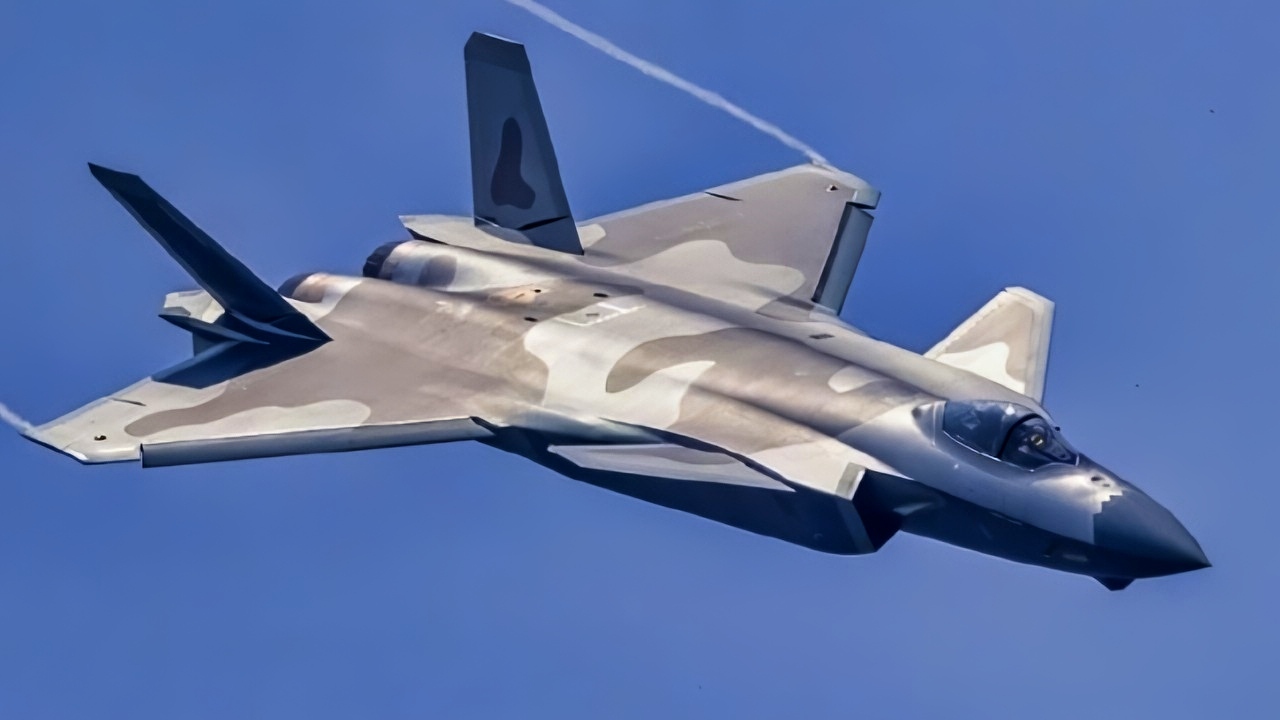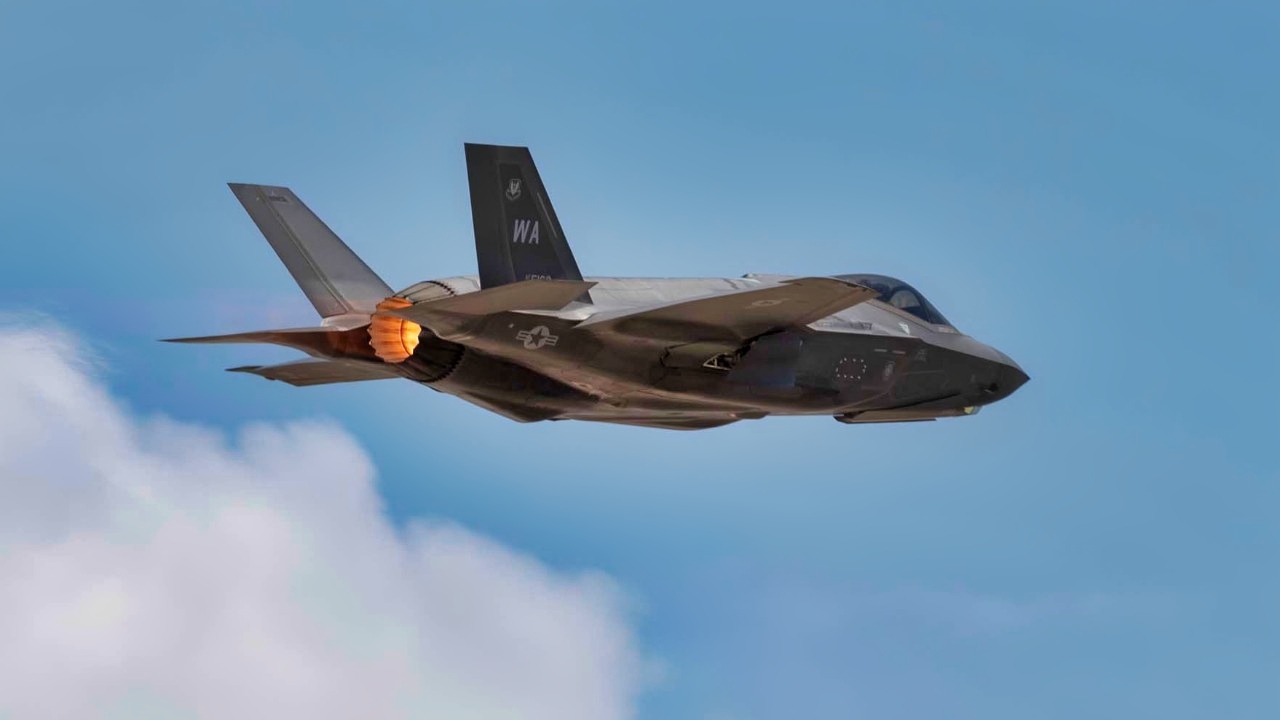Key Points and Summary – Born from the J-XX effort, China’s J-20 has matured into Beijing’s centerpiece air-dominance jet. The latest J-20A pairs thrust-vectoring WS-15 engines with canard-delta aerodynamics, DSI inlets and internal bays to emphasize range, persistence and low observability.
-The plane was built with one mission in mind: beat the F-22 or F-35 in combat.
-An AESA radar, IRST and passive sensors feed fusion and datalinks for teaming with drones; the twin-seat J-20S adds a mission manager.
-PL-15s cover long-range shots while PL-10s guard the merge. With production rising and units spread across theater commands, the type is designed to pressure U.S. enablers and fighters at BVR—even where F-22/F-35 retain a stealth edge.
Meet the J-20A Fighter
The Chengdu J-20 Mighty Dragon is currently the most advanced stealth fighter in the PLAAF’s inventory.
It was built as a response to American fifth-generation stealth fighters, namely the F-22 and F-35.
Over the years, the J-20 platform has been upgraded and improved multiple times, with better avionics, improved engine performance, and better stealth capabilities.
These efforts, along with China’s impressive industrial capabilities, have transformed the J-20 into a proper force to be reckoned with and a serious challenger to American air superiority.
The Mighty Dragon: Design and Development
The J-20 program originated from China’s J-XX initiative in the late 1990s, which aimed to develop a stealth fighter capable of competing with American stealth fighters like the F-22. The first prototype of the J-20 flew in January 2011, and the aircraft entered service in 2017.
Over the years, the platform evolved through several iterations, culminating in the J-20A, which features a revised airframe, thrust-vectoring control, and integration of the powerful WS-15 engine.
In terms of design, the J-20A maintains the distinctive canard-delta wing configuration of its predecessors, which provides excellent lift and maneuverability.
The aircraft features diverterless supersonic inlets (DSI), a chiseled nose, and a frameless canopy, all contributing to its low radar cross-section. The fuselage is long and blended, with leading-edge extensions that enhance aerodynamic performance. The twin outward-canted vertical stabilizers and deep ventral strakes further improve stability and control at high speeds.
Performance and Stealth Characteristics
Throughout the years, the J-20 has had its powerplant upgraded multiple times. Initially reliant on Russian made AL-31FM2 engines, the J-20’s performance was modest to say the least. Later variants are now equipped with the WS-10 or WS-15 engines. This domestically developed high-thrust turbofan engine delivers approximately 40,000 pounds of thrust per unit, enabling the aircraft to achieve supercruise.
This capability significantly enhances the J-20A’s operational range, speed, and agility. The WS-15 also improves fuel efficiency and reliability, addressing long-standing limitations associated with earlier Russian AL-31 and Chinese WS-10C engines.
Stealth is a cornerstone of the J-20A’s design. The aircraft incorporates radar-absorbing materials (RAM), internal weapons bays, and a carefully sculpted airframe to minimize radar cross-section. Analysts estimate the frontal radar cross-section to be around 0.027 square meters, which is slightly larger than the F-22’s 0.01 square meters but still highly effective.
The J-20A’s stealth features make it suitable for deep penetration missions into contested airspace, aligning with China’s broader anti-access/area denial (A2/AD) strategy.
Taking a Look inside the J-20
The avionics suite of the J-20A is highly advanced and designed for network-centric warfare. It includes an Active Electronically Scanned Array (AESA) radar system, believed to be the KLJ-5, with over 2,000 transmit/receive modules.

China J-20A Fighter in the Sky. Image Credit: Creative Commons.
This radar provides long-range detection and tracking capabilities, rivaling or surpassing those found in Western fighters. The aircraft also features electro-optical targeting systems, infrared search and track (IRST), and distributed aperture systems (DAS), which enhance passive detection and targeting capabilities.
In addition to its sensors, the J-20A is equipped with sophisticated data links that enable real-time communication with other aircraft, drones, and command centers. This capability supports manned-unmanned teaming (MUM-T), allowing the J-20A to coordinate with loyal wingman drones for reconnaissance, electronic warfare, or strike missions.
The twin-seat variant, the J-20S, further expands these capabilities by allowing a second operator to manage complex sensor data and drone coordination.
What Makes the Mighty Dragon So Deadly?
The J-20A is armed with a variety of weapons suited for both air superiority and precision strike roles. Its internal bays can carry PL-15 long-range air-to-air missiles, which feature AESA radar seekers and ranges exceeding 200 kilometers. For close-range engagements, the aircraft uses PL-10E infrared-guided missiles.
The J-20A can also deploy precision-guided munitions and potentially hypersonic weapons in future configurations.
External pylons are available for missions where stealth is not a priority, allowing for increased payload capacity.
The cockpit of the J-20A is designed to maximize pilot situational awareness and reduce workload. It features a glass cockpit with panoramic digital displays, a helmet-mounted display (HMD), and voice command capabilities.
These systems are integrated with highly sophisticated computers to assist in decision-making during complex missions. The twin-seat J-20S variant allows for even greater operational flexibility, with the second seat dedicated to managing sensors, electronic warfare, or drone operations.
A Direct Challenge to the U.S.
China has produced over 250 J-20 aircraft, with production rates exceeding 100 units annually. The J-20A is now the backbone of China’s strategic air dominance fleet and is deployed across all five PLAAF theater commands.
Its roles include air superiority, precision strike, electronic warfare, command and control, and drone coordination. The aircraft’s deployment along China’s eastern and southern maritime borders underscores its importance in regional power projection.
Even when compared to other stealth fighters, the J-20A is able to hold its own. It is faster and has a more extended range than the F-35, and its avionics and radar systems rival those of the F-22.

A U.S. Air Force F-35A Lightning II takes off for a mission during U.S. Air Force Weapons School Integration (WSINT) at Nellis Air Force Base, Nevada, June 3, 2025. WSINT serves as the culminating exercise for U.S. Air Force Weapons School students, bringing together air, space, and cyber forces in realistic, mission-critical training scenarios that mirror the complexities of modern warfare. Conducted twice a year, the integration event tests multi-domain operations and strengthens joint force interoperability, enhancing combat readiness across the spectrum of military operations over the Nevada Test and Training Range. (U.S. Air Force photo by William R. Lewis)
Nellis AFB; ACC; Las Vegas; Nellis Air Force Base; contentcollectionweek; readiness; US Air Force Weapons School; WSINT
While the Americans maintain superior stealth and dogfighting capabilities, the J-20A is flexible, and excels in BVR encounters. The F-35 is more widely produced and deployed, but the J-20A’s performance metrics suggest it is a serious challenger in any high-end air combat scenario.
About the Author: Isaac Seitz
Isaac Seitz, a Defense Columnist, graduated from Patrick Henry College’s Strategic Intelligence and National Security program. He has also studied Russian at Middlebury Language Schools and has worked as an intelligence Analyst in the private sector.
More Military
Why the U.S. Navy Loves the F-14 Tomcat
F-14 vs. MiG-29: The Winner Is Clear










